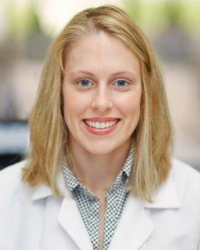Candidate Bio

Dr. Angela Sanford completed her undergraduate studies at Saint Louis University, double majoring in biology and psychology. She went to medical school at the University of Missouri-Columbia and then returned to St. Louis to complete a residency in internal medicine and a fellowship in geriatric medicine at Saint Louis University. She remained in academic medicine and is currently an Associate Professor of Internal Medicine in the division of Geriatric Medicine at Saint Louis University and is serving as the interim division director. Dr. Sanford has a robust clinical practice spanning the geriatric continuum of care and teaches medical students, residents, and fellows in the outpatient clinic, nursing home, retirement community, and on the geriatric inpatient and consult service in the hospital. She also serves as a medical director in a skilled/long-term care facility, a retirement community, and home health agency.
Dr. Sanford has been a member of AMDA since graduating fellowship in 2013. She has been a speaker at the annual AMDA conference since 2015 when she filled in for Dr. Milta Little at the “Difficult Issues in Long-Term Care” session. In the subsequent years, Dr. Morley was kind enough to allow Dr. Sanford to speak in his place for the same session and she has been speaking each year since. In 2017, she began presenting the popular “Year in Review” session annually at the conference with Drs. Little and Gammack. She has additionally been active in the AMDA organization by serving on the Governance Committee and as a member of the House of Delegates. She is also active in her local state AMDA chapter, the Missouri Association of Long-Term Care Practitioners (MALTP), serving as a board member, and regularly communicates with other MALTP members.
Outside of her career, Dr. Sanford is a mom to 4 energetic children and a wife to a busy hepatobiliary surgeon. She has been the manager of her oldest son’s baseball team for 5 years and was a Boyscout Den leader for 3 years. She is a robust master of schedule-keeping for sports, activities, and school tests, and spends evenings carpooling and re-learning new math methods with her children who are in 4th, 5th, and 6th grades. With varying success, she is also actively potty-training her two-year old.
Candidate Statement
The year 2035 marks the transition point where more individuals will be over the age of 65 than under age 18 for the first time in history! Potentially, there will be more non-working than working individuals. Do you think our healthcare infrastructure is equipped to handle this shift in healthcare utilization? Now, more than ever, it is crucial to build an aging-friendly healthcare system and it is essential that AMDA members, who are the experts in providing comprehensive health care to older adults, have a seat at the table. We understand the challenges and lack of resources that are obstacles to healthcare delivery in the post-acute and long-term care (PALTC) setting. It is up to us to be the impetus for change and to keep advocating for and providing a voice for those we passionately care for on a day-to-day basis.
It is with great honor that I submit my name as an applicant to serve AMDA as the Chair of the House of Delegates (HOD). As the governing body of the organization, the HOD develops and debates policy recommendations for the Board of Directors, approves amendments and changes to AMDA’s bylaws, and elects new officers to the Board of Directors. AMDA’s HOD is instrumental in recommending policy changes at the state and national level, and can be a unified voice representing PALTC patients, healthcare providers, and AMDA members. For the past seven years, I have served as a HOD representative for my home state, Missouri, and am familiar with the structure of the HOD and voting process. In my experience as a state representative, I have seen the components of successful policy development and how the Chair of the HOD facilitates this process. As the working mom of 4 children, I can offer my skills of organization, multi-tasking, efficiency, and can bring a voice of calm when the policy development and debate gets heated. I believe that I can facilitate finding common ground and unity in the face of division and promote achieving the common goal of improving healthcare delivery in the PALTC setting.
My work in long-term care spans over 12 years and I have been a medical director for 10 years. Throughout this time, I have witnessed mounting pressures to deliver increasingly complex care in a setting lacking financial and workforce resources, technology, and even basic equipment. We are all treating high-acuity patients that previously would have been best served in the inpatient hospital setting, without adequate resources or compensation, and our success is judged by metrics such as hospital readmission and return to the community rates. Our PALTC patients are becoming older and sicker, and the expectation is that the care delivery in PALTC settings match this higher acuity. I often joke with my facility’s director of nursing that I just want a “knee replacement” admission but am instead tasked with rehabbing the stage 4 lung cancer patient with a pathologic femur fracture, advanced frailty, severe hyponatremia and anemia, and with moderate dementia who plans to return home alone after “a week of physical therapy.” We sure have all the guts but no glory in PALTC, right? AMDA has been and will continue to be a driving force in advancing technologies in and improving resource allocation to the PALTC setting at the national level. This advocacy will be particularly impactful in rural PALTC settings who face even greater obstacles.
One of the biggest challenges facing AMDA is the workforce shortage in PALTC. This shortage spans the continuum and includes PALTC physicians, mid-level providers, RNs, LPNs, and care partners and will likely grow as the demand for PALTC beds increases with the growing population size of older adults Through policy development in the HOD and advocacy as an organization, we will have to tackle this with a multi-faceted approach that spans improved education and exposure for trainees at all levels, improved compensation and retention models for the workforce, and reversal of the negative stigma encompassing the PALTC setting as a whole.
Thank you for considering me for this position of the Chair of the House of Delegates. I am so grateful for this opportunity to serve AMDA and the PALTC workforce. I will bring forth my passion for geriatrics and my work experience in PALTC to further support the AMDA mission.

